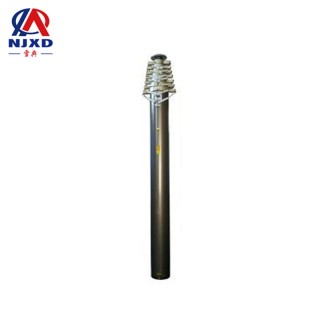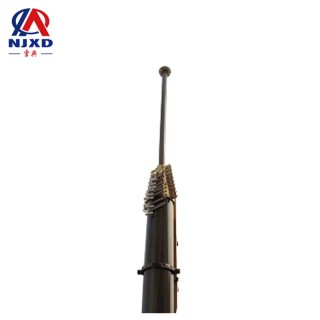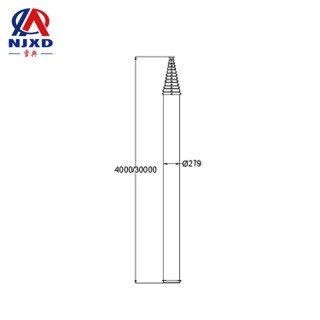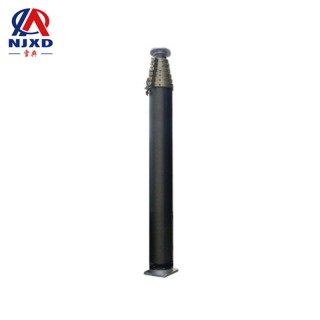NEWS
Technical description related to pneumatic lifting bracket materials
Time:2020-09-22 View:

◆ Technical description
The cylinder material of Nanjing Xuedian pneumatic lifting rod-aluminum alloy 6063-T5
The main alloy elements are magnesium and silicon, which have excellent processing performance, excellent weldability, extrusion and electroplating property, good corrosion resistance and toughness, easy polishing and coloring film, it is a typical extrusion alloy with excellent anodic oxidation effect. 6063 aluminum alloy profiles are widely used in building profiles, irrigation pipes, due to their good plasticity, moderate heat treatment strength, good welding performance, gorgeous surface color after anodic oxidation treatment, etc, pipes, rods and profiles for vehicles, bench, furniture, lifts, fences, etc.
Density: 2.69g/cm3
Chemical composition: iron (Fe)0.35 manganese (Mn)0.1 magnesium (Mg)0.45~0.9
Silicon (Si)0.2~0.3 zinc (Zn)0.1 titanium (Ti)0.1
Chromium (Cr)0.1 copper (Cu)0.1
Aluminum (Al) residual heat treatment code-(name)
T1 -- artificial aging T2 -- annealing
T4 -- solid solution treatment * plus natural aging T5 -- solid solution treatment plus incomplete manual aging * *
T6 -- solid solution treatment plus complete manual aging *** T7 -- solid solution treatment plus stabilization treatment * * * *

* Solution treatment
It refers to the heat treatment process of heating the alloy to the high-temperature single-phase zone and keeping the temperature constant, so that the excess phase can be fully dissolved in the solid solution and then quickly cooled (water cooled) to obtain the supersaturated solid solution.
**Incomplete manual validity
Using relatively low aging temperature or short heat preservation time, excellent comprehensive mechanical properties are obtained, I .e. relatively high strength, good plasticity and toughness are obtained, but the corrosion resistance may be relatively low.
*** Full manual aging
Higher aging temperature and longer holding time are adopted to obtain the maximum hardness and the highest tensile strength, but the elongation is relatively low.
**** Stabilization treatment
In order to keep the shape and size changes of the workpiece within the specified range of heat treatment under the condition of long-term service.

Nature
A class of synthetic rubber prepared by emulsion polymerization of butadiene and acrylonitrile. The appearance is light yellow solid with a relative density of 0.91~0.986. Acrylonitrile is randomly distributed in the molecular chain and belongs to non-crystalline rubber.
Performance
Nitrile rubber is a kind of rubber with excellent oil resistance and heat resistance. Due to the existence of polar nitrile groups in its structure, non-polar or weak polar mineral oil, animal and vegetable oil, both fuel oil and solvent have high stability.
Nitrile rubber has a wide application temperature range and can be used for a long time in air at 120℃. The oil resistance and heat resistance of nitrile rubber increase with the increase of its acrylonitrile content, but the cold resistance, wear resistance and elasticity of rubber decrease with the increase of acrylonitrile content.
There are more than 320 varieties and grades of nitrile rubber, which can be divided according to the content of bound acrylonitrile: 42% ~ 46% is extremely high nitrile, 36% ~ 41% is high nitrile, 31% ~ 35% is medium and high nitrile, 25% ~ 30% is medium nitrile and below 25% is low nitrile 5 grades.
According to the polymerization temperature: high temperature polymerization of nitrile rubber, potassium persulfate as initiator, polymerization temperature of 30 ~ 500℃, also known as hard nitrile rubber; Low temperature polymerization of nitrile rubber, using isopropyl hydrogen peroxide-sodium ethylenediamine tetraacetate-ferrous sulfate-carved powder as initiator, the polymerization temperature is 5 ~ 100℃, which is also called soft nitrile rubber.
The quality and processing performance of soft nitrile rubber are better than those of hard nitrile rubber. There are also methods to classify according to the size of money value, physical state and antioxidant, etc.
Nitrile rubber is mainly used to manufacture oil-resistant rubber products, widely used in molding products, extrusion products, sponge products, asbestos products, industrial rubber rolls, oil-resistant rubber shoes, wires and cables, mountant, plasticizer and building materials.
The process of forming an oxide film on the anode of aluminum and its alloy in the corresponding electrolyte under specific working conditions and under the action of external current is called anodic oxidation.
After hard oxidation, the surface of aluminum and aluminum alloy has higher hardness, film thickness, abrasion resistance and corrosion resistance.
Difference between aluminum and aluminum alloy hard anodic oxidation and ordinary anodic oxidation surface oxidation film

Differential features
Name hard anodic oxidation ordinary anodic oxidation (take 6061 as an example)
Hardness of oxide film HV ≥ 400HV<300
Oxide film thickness> 30um-200um10um
The color characteristics are most suitable for brown, black and easy to wear all kinds of colors
According to the surface requirements of different aluminum products, different oxidation processes are selected. If only the surface decoration requirements, choose ordinary anodic oxidation; If the requirements of product surface hardness and wear resistance are emphasized, choose hard anodic oxidation. Compared with copper alloy, aluminum alloy weighs only 1/3, and some hard oxidation aluminum products can replace copper, which can greatly save the material cost and have a long service life at the same time.

CATEGORY
NEWS
- Selection and detailed introduction of pneumatic lifting bracket
- Technical description related to pneumatic lifting bracket materials
- Technical Index and application of pneumatic lifting rod with built-in line
- Application of production process of pneumatic lifting rod in Mobile Command Vehicle
- Selection of pneumatic multi-section cylinder lifting mast and hard oxidation technology